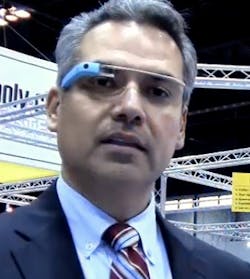It’s the End of Google Glass As We Know It
In case you missed it, Google announced last week that Google Glass, as we know it today, is coming to an end. Far from being abandoned, the technology is moving out of Google’s Explorer Program and getting its own team. Though the technology is not disappearing, this move does mean that, at least for the time being, you won’t be able to get Google Glass. Google ceased sales of the Glass Explorer Edition (the latest version) on January 19.
According to a report posted by Bloomberg.com, Google Glass research and development will now be led by Tony Fadell, who heads digital thermostat maker Nest Labs, which was purchased by Google last year.
Considering all the interest Google Glass has generated in the manufacturing space since its introduction, I reached out to several automation technology suppliers who've made mention of significant plans for technology developments around Google Glass. Here’s what they had to say about the end of Google Glass as we know it.
“Wearable HMI for automation concepts as demonstrated by Beckhoff Automation have been exciting subjects of discussion with numerous customers and trade show booth visitors,” says Aurelio Banda, Beckhoff Automation president. “This already has taken the form of Google Glass and smart watches, and the approach can conceivably be adapted to any web-enabled device from a consumer electronics manufacturer. Whatever the form of a new wearable connected device from Google ̶ or other electronics manufacturers such as Apple, Samsung, and Microsoft—they will be easily integrated with machinery and other automated equipment via standard PC-based hardware and software tools from Beckhoff.”
Banda says he finds it “exciting” to hear that Google’s product development is working on a new Glass product with a business-focused program for the eyewear. “I am confident the company will continue to introduce new wearable technologies in a similar spirit to the innovative Google Glass—more than likely in more advanced, yet less expensive offerings,” he adds.
Tobias Antius, CEO of Novotek AB, a GE Intelligent Platforms’ channel partner working on an application with Google Glass, says he believes the shift inside of Google in relation to Glass is expected when such a product matures. “I expect that Google Glass will reemerge under the same or a new name,” he says. “Google Glass has always been one potential wearable for the use we seek and the augmented reality field will develop with or without Google Glass. Our solution is using Google Glass today, but the technology is usable with any wearable that provides visualization possibilities.”
Pointing out that the latest version of Google Glass had a number of challenges, Kevin McClusky, director of design services for Inductive Automation, says the biggest issue he saw was the price of Google Glass.“$1,500 is a lot to drop on any technology, whether using it in the industrial sector or for personal use. Another issue I had was with the physical design. Although Glass worked fine, it wasn't industrialized, waterproof, or certified for any plant floor operation.”
Despite these shortcomings, McClusky notes that “Glass started a fairly strong research movement in optical wearables. Companies around the world took notice and started working on competing technologies,” he says.
Andy Chang, senior manager of academic research at National Instruments (NI) also makes a clear distinction between consumer-oriented wearables, such as Google Glass, and industrial-ready wearable technologies. “Although there has been some interesting ongoing discussion around the similarity and differences between the Consumer Internet of Things (CloT) and the Industrial Internet of Things (IIoT),” says Chang, “it’s important to note that the applications used in Google Glass are very different than the applications in which our technology has been deployed on similar wearables. For example, while many popular CIoT devices—such as the Pebble Smart Watch and Google Glass—have been popular trends with a short lifespan, technology such as the Actigraph, which utilizes NI technology, has been used as physiological monitoring systems for many years by both the government and military. The smart glasses we worked on with Airbus are a great example of how NI is taking a consumer product and adding intelligence and reliability—through system on module technology—so that it is IIoT ready.”
Looking forward, McClusky says that “some see the recent announcement as the lowering of the Glass coffin. However, I think there's a different angle to all this. With the first iteration of Glass, Google did its best to address the one issue that it could really focus on, which was the software. However, to address the physical design challenge, a fundamental change is needed.”
In response to this, McClusky expects any new version of Glass to be more like the Nest products—“sleek, elegant, modern, attractive, and very functional. I really hope to see something that projects onto eye glasses/safety glasses, and would love to find some industrial certifications to go along with it. I also have a feeling a more affordable unit is likely a strong design goal. A price tag more in the $750 range for the new version would really help with overall adoption and ultimately the success of the platform.”
Based on these comments, the continuing development of Google Glass will certainly mean changes for technology as we know it, but the automation industry feels fine about it.
About the Author
David Greenfield, editor in chief
Editor in Chief

Leaders relevant to this article:
